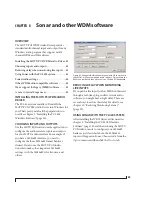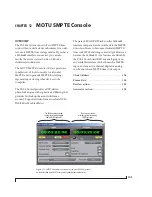
R E D U C I N G M O N I T O R I N G L A T E N C Y
92
MONITORING LIVE INPUT
There are two ways to monitor live audio input
with a MOTU PCI-424 system: 1) through the
computer or 2) via CueMix™ DSP hardware
monitoring. Figure 10-1 on page 92 below shows
method 1, which allows you to add effects
processing such as reverb and guitar amp effects
via plug-ins in your audio software. See the next
section, “Samples Per Buffer” for details about how
to reduce — and possibly eliminate — the audible
monitoring delay that the computer introduces.
Figure 10-2 shows how to use CueMix™ DSP
hardware-based monitoring, which lets you hear
what you are recording with no monitoring delay
and no computer-based effects processing. (You
can add effects later, after you’ve recorded the live
input as a disk track.) See “CueMix DSP hardware
monitoring” later in this chapter for details on how
to use CueMix DSP with your audio software, or
with the included CueMix Console software.
If the material you are recording is suitable, there is
a third way to monitor live input: use both methods
(Figure 10-1 and Figure 10-2) at the same time. For
example, you could route vocals to both the
computer (for a bit of reverb) and mix that
processed signal on the main outs with dry vocals
from CueMix DSP.
THE SAMPLES PER BUFFER SETTING
As shown in Figure 10-3, the
Samples Per Buffer
setting determines the size of the buffers used by
the PCI-424 drivers to transfer audio to and from
the PCI-424 hardware. This setting can be used to
reduce latency.
1. Live input (from mic, guitar, etc.)
enters the MOTU interface.
PC
2. Mic signal goes immedi-
ately to the computer (dry,
with no effects processing).
3. Mic signal is ‘patched thru’
back to the audio interface
with reverb or other plug-in
effects, if any.
Figure 10-1: There are two ways to monitor live audio inputs with a PCI-424 system: 1) through the computer or 2) via CueMix™ DSP hardware
monitoring. This diagram shows method 1 (through the computer). When using this method, use the PCI-424’s ‘Samples Per Buffer’ setting to
reduce the slight delay you hear when monitoring the live input, but don’t lower it too much, or your computer will act sluggish.
4. Mic signal (with plug-in
processing, if any) is routed
to the main outs (or other
outputs that you’ve specified
in the software).
Summary of Contents for PCI-424
Page 35: ...6 ...
Page 43: ...14 ...
Page 45: ...16 ...
Page 53: ...P A C K I N G L I S T A N D P C S Y S T E M R E Q U I R E M E N T S 24 ...
Page 83: ...I N S T A L L I N G T H E P C I 4 2 4 H A R D W A R E 54 ...
Page 103: ...M O T U P C I A U D I O C O N S O L E 74 ...
Page 111: ...C U B A S E N U E N D O A N D O T H E R A S I O S O F T W A R E 82 ...
Page 115: ...S O N A R A N D O T H E R W D M S O F T W A R E 86 ...
Page 119: ...E X P A N D I N G Y O U R P C I 4 2 4 S Y S T E M 90 ...
Page 125: ...R E D U C I N G M O N I T O R I N G L A T E N C Y 96 ...
Page 131: ...C U E M I X C O N S O L E 102 ...
Page 148: ...6 ...
Page 156: ...14 ...
Page 158: ...16 ...
Page 166: ...P A C K I N G L I S T A N D M A C I N T O S H S Y S T E M R E Q U I R E M E N T S 24 ...
Page 194: ...I N S T A L L I N G T H E P C I 4 2 4 H A R D W A R E 52 ...
Page 230: ...A U D I O D E S K 88 ...
Page 246: ...E X P A N D I N G Y O U R P C I 4 2 4 S Y S T E M 104 ...
Page 258: ...C U E M I X C O N S O L E 116 ...
















































